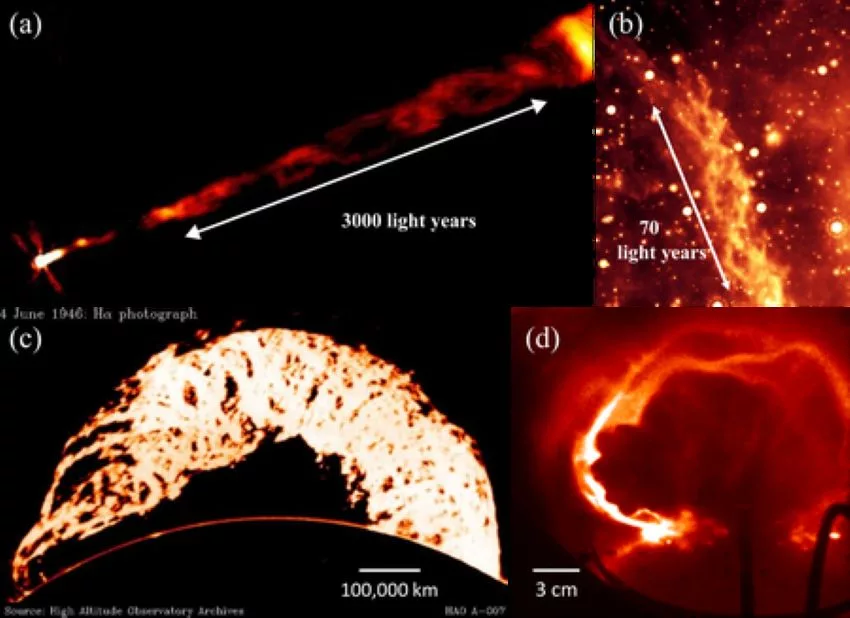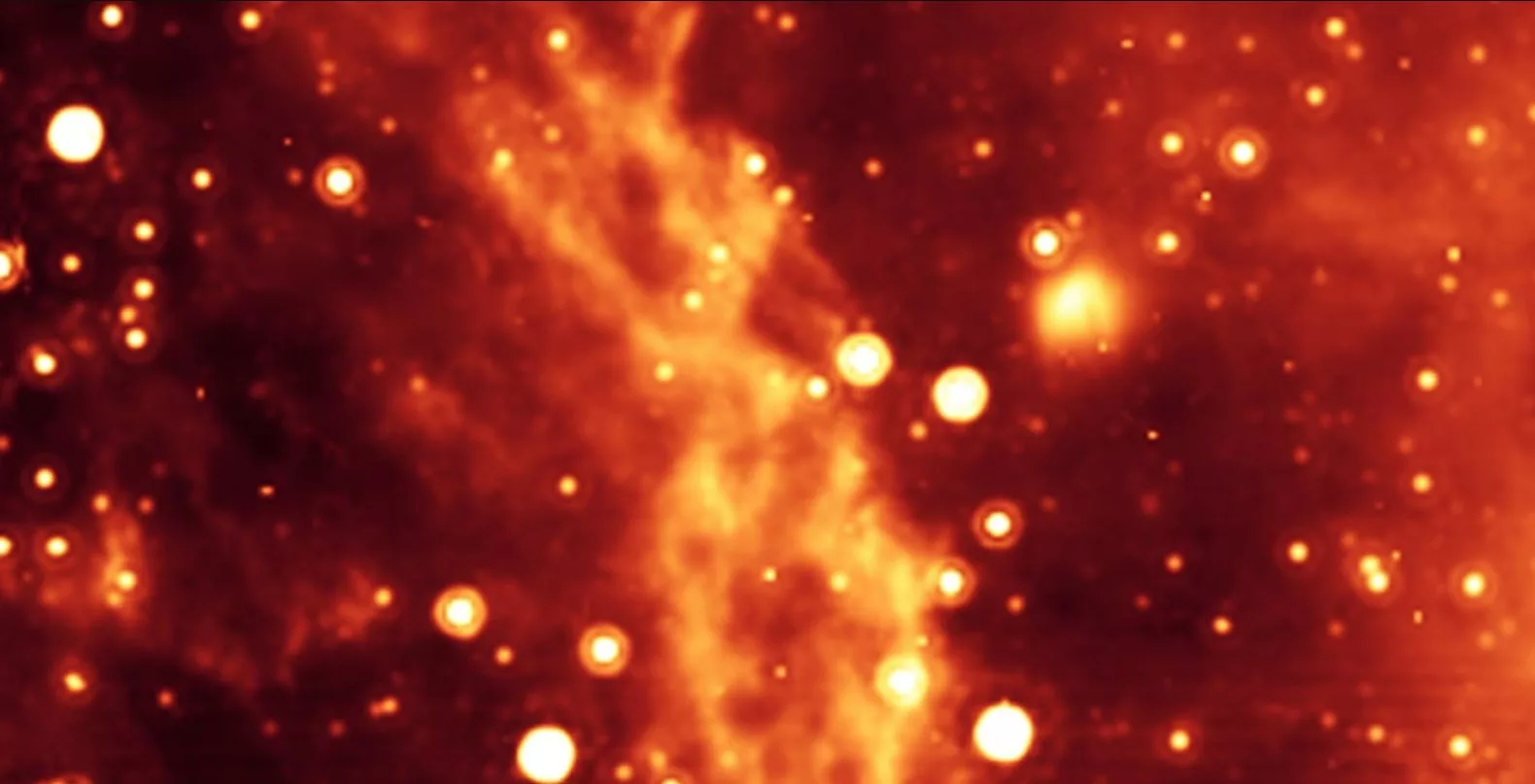What do solar flares, lab-grown plasma, and a nebula 25,000 light-years away have in common? A cosmic twist, literally.
In a breakthrough that braids together the Sun’s outer atmosphere and the heart of the Milky Way, Caltech physicist Paul Bellan and NASA postdoctoral fellow Yang Zhang have uncovered a new equilibrium state in magnetized plasma: a double helix structure that holds steady under cosmic tension.
The solar corona, an ethereal halo of plasma that’s a million degrees hotter than the Sun’s surface, is home to magnetic flux ropes: twisted tubes of plasma that behave like electrified garden hoses. These ropes, charged and frozen into magnetic fields, are the engines behind solar flares and coronal mass ejections. But until now, scientists didn’t fully understand what happens when these ropes braid together.
Using a vacuum chamber and a pair of electrodes, Bellan and Zhang recreated miniature solar flares in the lab, just 10 to 50 centimeters long. What emerged was a stable double helix: two flux ropes spiraling around each other in perfect magnetic balance.
“We have two electrodes inside the vacuum chamber, which have coils producing a magnetic field spanning the electrodes. Then we apply high voltage across the electrodes to ionize initially neutral gas to form a plasma. The resulting magnetized plasma configuration automatically forms a braided structure,” Zhang explains.
And unlike previous assumptions, the ropes didn’t merge or collapse; they held their shape without tending to twist tighter or untwist.
In their new study, Zhang and Bellan show that the double-helix structure formed by braided magnetic flux ropes can reach a stable balance, and that this balance can be predicted using math.

Credit: (a) Passeto et al., Sophia Dagnello, NRAO/AUI/NSF; (b) NASA/JPL-Caltech/M. Morris (UCLA); (c) High Altitude Observatory Archives; (d) Yang Zhang, Caltech Bellan Plasma Lab
While scientists already understand single flux ropes well, braided ones, especially when both strands carry electric current in the same direction—have been more mysterious. Most models focused on the opposite case, where currents flow in opposite directions, but that setup is rare in nature.
The same-direction current setup is crucial because it’s prone to twisting and expanding due to magnetic forces, a behavior seen in both solar flares and lab experiments. These effects don’t happen when the currents cancel each other out, as in the opposite-direction case.
Scientists used to think that when two braided magnetic flux ropes carry current in the same direction, they’d naturally merge, because parallel currents attract each other magnetically. But in 2010, researchers at Los Alamos National Laboratory discovered something surprising: instead of merging, these flux ropes actually bounce off each other when they get close.
“There was clearly something more complicated going on when the flux ropes are braided, and now we have shown what that is. Suppose you have electrical currents flowing along two helical wires that wrap around each other to form a braided structure, as seen in our lab. In that case, the components of the two currents flowing along the length of the two wires are parallel and attract, but the components of the two currents flowing in the wrapping direction are anti-parallel and repel.”
“This combination of both attractive and repulsive forces means there will be a critical helical angle at which these opposing forces balance, producing an equilibrium. If the helical flux ropes twist tighter, there will be too much magnetic repulsion; if they twist more loosely, there will be too much magnetic attraction. At the critical angle of twist, the helical structure arrives at its lowest energy state, or equilibrium.”
To crack the mystery of how braided flux ropes behave, Zhang took on the challenge of building a mathematical model, something no one had done before. Using what Bellan calls “brute force mathematics,” Zhang developed equations that work across different flux tube setups, including the tricky double-helix braids. His model revealed that these ropes can reach a stable state where magnetic attraction and repulsion perfectly balance out.
And there was a bonus: Zhang’s equations didn’t just predict equilibrium, they also mapped out the magnetic fields inside and outside the ropes, along with the current and pressure within. As Bellan put it, this gave scientists a complete picture of how these twisted plasma structures behave.
A powerful plasma rope found in the Universe
To test the model’s reach, Zhang applied it to the Double Helix Nebula, a massive plasma formation stretching 70 light-years across, located 25,000 light-years from Earth. The goal? To see if the math held up not just in the lab, but in the vastness of space. Spoiler: it did.
“What was rather amazing about this calculation is that Yang didn’t really need to know much about the nebula,” Bellan says. “Just knowing the diameter of the strands and the periodicity of the twist, numbers that can be observed astronomically, Yang was able to predict the angle of twist that yielded an equilibrium structure, and that was consistent with observations of this nebula.”
“One of the most exciting aspects of this research is that magnetohydrodynamics, the theory of magnetized plasmas, turns out to be fantastically scalable. When I first started looking into this, I thought the phenomena of magnetic structures at different scales were qualitatively similar. Still, because their sizes are so different, they couldn’t be described by the same equations. It turns out that this is not so. What we see in lab experiments and in solar and astrophysical observations is governed by the same equations.”
Journal Reference:
- Yang Zhang and Paul M. Bellan. Magnetic Double Helix. Phys. Rev. Lett. DOI: 10.1103/sz9k-6l22
